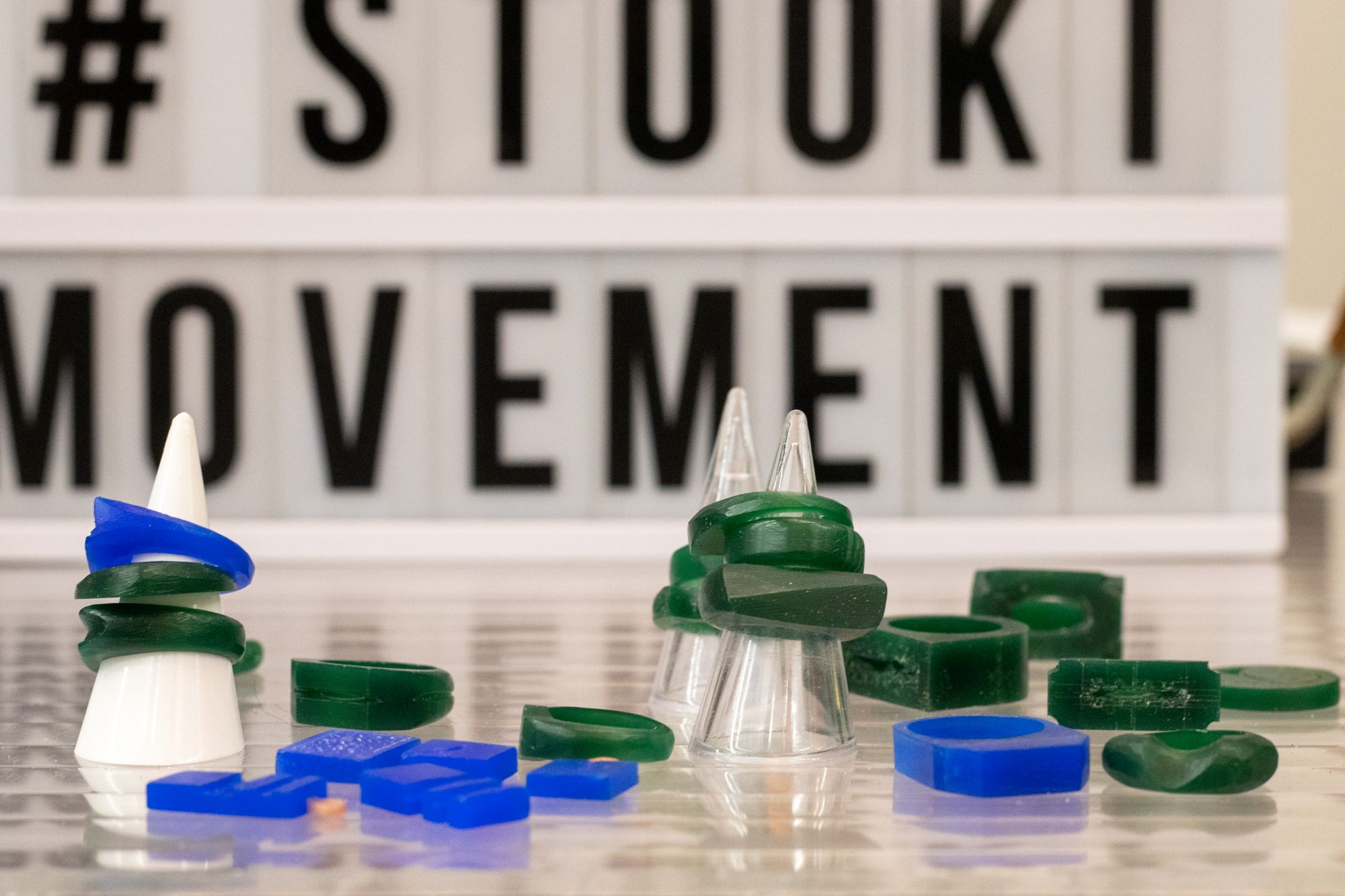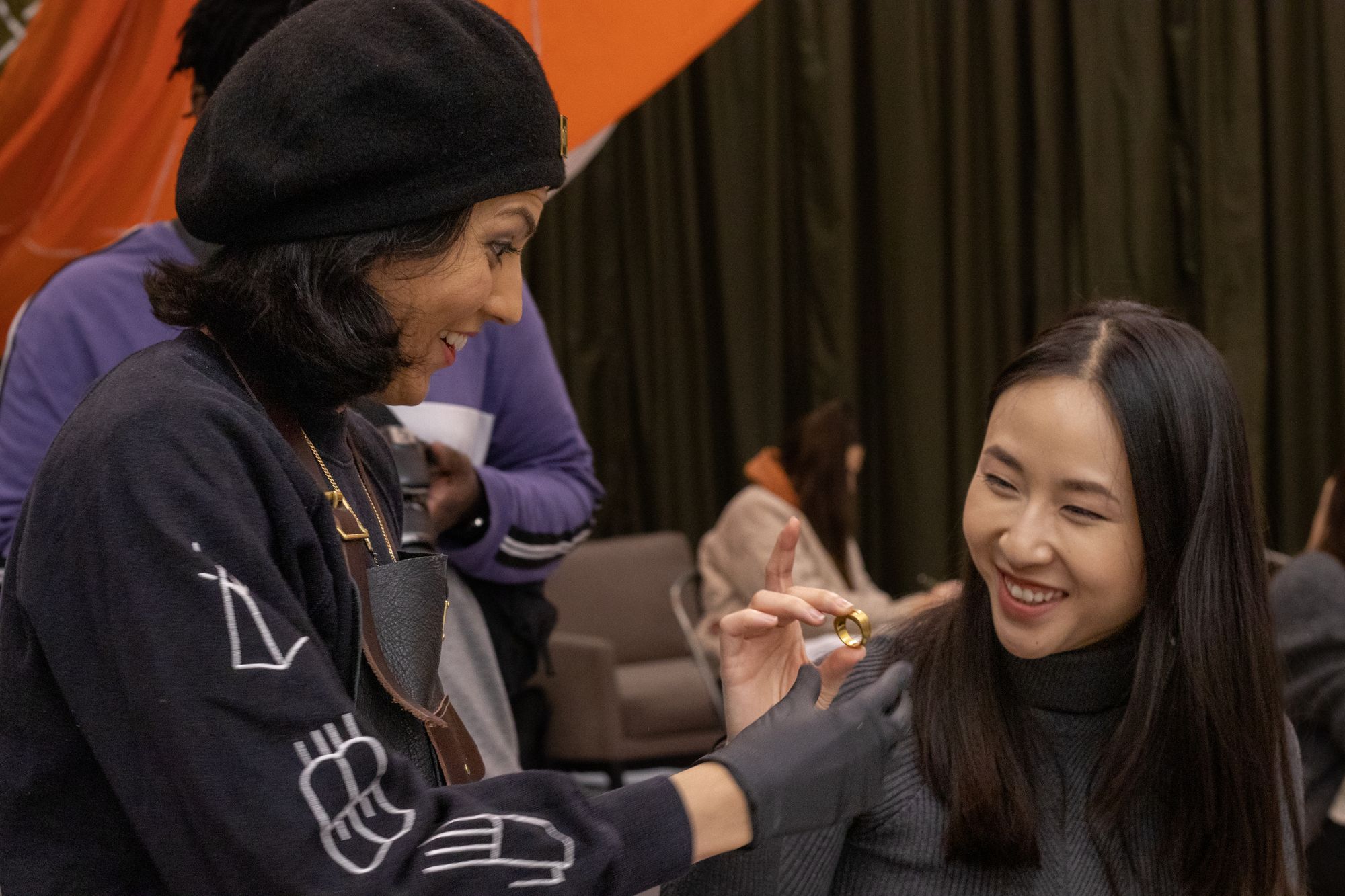When I sit down with Nadia and Luke to begin our chat, they're just half an hour away from starting their sold-out workshop in East Village, Stratford. You wouldn't know it though, as from their relaxed and warm demeanour it feels as though we have all the time in the world to talk.
It was clear from the moment I met the pair that they're both equally passionate about what they do, something seen even down to how they lay out the materials for their class - making sure every piece is set out perfectly. With Stööki turning 10 this year, having been founded in 2011, it's inspiring to see that their passion is still very much alive, even after a decade.
I chatted to the both of them about how they started out in the jewellery-making industry, their teaching journey, and how they've managed to keep their passion throughout the years.
Check out Stööki's Classes
(Nadia and Luke’s answers have been edited for clarity and length)
So, just to get started, tell me a little bit about who you are and what you do!
Nadia: Sure! I’m Nadia Abbas, I’m one of the co-founders of Stööki. My role (as Jewellery Technician for the brand) mainly focuses on the making and production side, so I handle all the accounts and boring stuff which has to be done! I also help in the design process, and in making bespoke pieces.
Luke: And I’m Luke Hippolyte, I’m also a co-founder of Stööki. I’m in charge of the creative direction for the brand, so the graphic design, branding, photography and social media. Nads (his nickname for Nadia) and I also team up together to design and create our jewellery collections.

So, Nadia first - when did you first start working with and creating jewellery, and what drew you to it?
N: My background is actually in jewellery making, I studied it at uni, but I fell into it kinda by accident! I’ve always been creative, but when I was looking at what uni course to do, none of them really inspired me. There was one teacher, who I’ll never forget, who when I told her this said “Oh why don’t you try jewellery design?” At that point, she saw something in me that I didn’t even know I had! Now looking back at the journey I’ve had with Stööki, and my jewellery making experience, I can’t imagine doing anything else.
I love how it was a teacher that helped inspire you to follow the jewellery-making path! I had a few teachers like that at school, and it really makes difference.
N: It’s actually kind of crazy, when I was studying for my jewellery-making degree I had another teacher who told me I would never make it! It’s kinda crazy she said that, because I feel as a teacher you should be there to encourage your students, not put them down. I think that was when I took it seriously, because it motivated me to prove her wrong and I feel I’ve already done that - even though I’ve not been in the industry as long as other jewellers.

And Luke, same question to you? What drew you to working with jewellery?
L: We started Stööki in the summer that both Nads and I graduated, along with our third business partner and co-founder Quincey, who sadly passed away in 2014. I had been studying graphic design, and I enjoyed the course, but wanted to get some experience working on real-life projects. We were all in a similar situation, so we teamed up to work on one concept design - some pendants which went with screen printed t-shirts. By the end of the summer, we decided to try and put it out ourselves under our own brand. We did our first launch at the Red Bull Studios, with a mixture of music and installations alongside our jewellery. That’s where the key Stööki elements of sound, vision, and play - as music, art, and fashion - came about.
You touched on building the brand, which feeds into another question I was going to ask you - where did your brand name come from?
L: As I mentioned before about Quincey, the fellow co-founder of Stööki, it was actually his nickname as a kid growing up! He had Jamaican heritage, it’s actually a dance and song in Jamaica, and to be ‘stooki’ means to be playful. We added the umlauts to the O’s to create a unique name, and so we kind of created our own meaning of the word.

Obviously, you make jewellery for the brand, but when did you realise that teaching jewellery-making workshops would be something you would be interested in?
N: I think it came about very organically, we only started the jewellery making workshops in 2019, so it’s a more recent thing. In my experience, the jewellery industry has been very closed off, and it’s hard to break in unless you’ve got connections. So the idea of putting on workshops for our target audience, we wanted to open their eyes and show them that this a career path that they could take if they wanted. The jewellery industry is a dying craft, because there’s no one there to pick up the skills left behind by older crafters. We also really believe in making things with love and effort, and it’s nice to see people recognising that when they attend our workshops.
L: I 100% agree with all of that. I think the only thing I’d add is that, as Stööki, we try and be as transparent as possible in our entire process. So these workshops are a really great opportunity to invite people into our world. So many people want to make their own pieces, and come with their own sketches and ideas - they really appreciate the chance to create the physical piece they’ve always wanted to make.


In terms of the transition from creating for Stööki as a brand, to then teaching those skills in a workshop environment - how do you find going from being in a business headspace to a teaching one?
N: I don’t think I’ve thought of it like that before! I’m just teaching people the skills that I know, I don’t really see a barrier between the two. I do simplify it, especially with some of the terminology I use, because our workshops are catered towards people of all experience levels. Especially because our sessions are only 2 hours long, so it’s a real crash course into the technique of wax carving - especially because what I normally teach in a workshop will take me a full day to do! But as Luke said, our sessions are very transparent and we welcome any questions people may have about the process.
For my next question, and you kind of touched on it at the beginning Nadia, as co-founders, how do you manage the more mundane responsibilities of running a business with your creative sides?
N: The mundane stuff, it really overtakes when you start a business, because it’s so much to keep on top of. And then you find you’re left with less time for the creative stuff, the stuff you got into the business for! So, you really have to be strict, and make sure you’re giving yourself enough time to do everything. It’s the creative stuff that motivates me, and keeps every day fresh, but the accounts aren’t gonna do themselves!

I think that feeds really nicely into another question I had for the both of you! How do you maintain your creative inspiration when you have to deal with those mundane everyday tasks?
L: I think, with Stööki, because we shaped it out of our personal passions that’s been the fuel to keep going. We’re always bringing the elements of art, music and fashion into the brand, so whenever we’re creating pieces were always thinking about those. As a brand, we also do collaborations other artists, and we started building what we call the ‘Stööki movement’ - which is like the creative network we lacked when we started out 10 years ago. We have a series called Self-Made on our blog, where we put a spotlight on other creatives in different fields that are on their own kind of journey. I think that has been inspiring and encouraging, to work with our peers.

That perfectly answered another question I had about Stööki as a movement, not just a brand, and I think it’s really inspiring that you’re helping create that space and network for a new generation of creatives.
And so that inspiration, how do you pass it on to your students?
N: I think people already have that interest when they come to our workshops, so it doesn’t take much for them to get motivated. I think it varies in the individual, but it’s almost always a good vibe in the workshop. Most people come with a friend or a partner, so it becomes a social event where you’re doing something together. I think - as I touched on in another of my answers - it helps opens people’s eyes to the value of what we do, and be inspired by the work that goes into the craftsmanship of it.

So, my final question for you guys is, do you have any tips or anything to help aspiring creatives who are looking to start their own business - who have that passion but don’t know how to take that final step?
N: Never take no for an answer, and don’t let people put you down or tell you you’re not good! Because, as long as you believe in yourself, I feel like you will always find a way. And there will always be doors that close, but there will also be lots of opportunities that present themselves. So, just keep going.
L: I think your passion for your craft is the key, and it will keep you motivated along the way. There are gonna be setbacks, but it’s important that you bounce back and believe in yourself. I think also there are a lot of online resources, on the business side of things, which can help - it’s important to focus on that aspect of it, so as a business you can become sustainable. There are lots of grants for new artists, such as the Prince’s Trust or local grants, such as the Arts Council. I think creativity wise, just keep doing what you’re doing. The more you do, the more you’ll learn and you can keep improving from there.
Check Out Stööki's Classes
Want to know more?
Interested in finding out more about our wonderful teachers? Check out some more blogs featuring Obby teachers and their stories below:
- Story Telling with Paint Chill Co - the Paint and Sip company with a focus on fun
- Introducing: La Cucina Caldesi Cookery School
- Story Telling with Flower Factory London
- Elliot Walker, star of Netflix's hit series Blown Away, joins Obby
- Story Telling with Saddleworth Cookery School - teaching cooking skills that are infused with love

